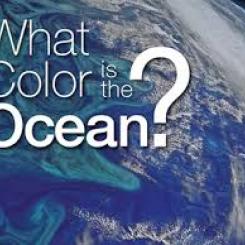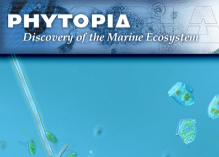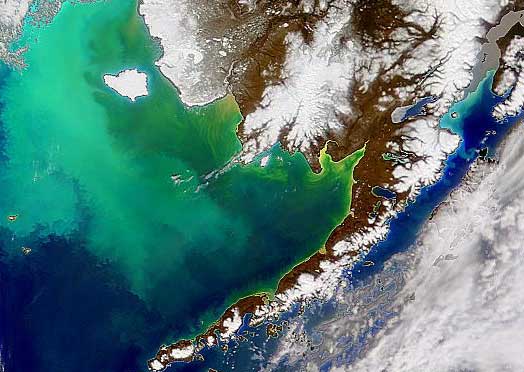Lesson Plans
Phytopia: Exploration of Marine Ecosystem
Overview
Students use Phytopia: Exploration of the Marine Ecosystem, a computer-based tool, to investigate various phytoplankton species and topics relating to phytoplankton biology. Phytopia features a concept mapping ability to help guide students exploration of the phytoplankton ecosystem. Credit: NASA's PACE Mission.
Materials Required
- Get to Know Phytos - Student Sheet
- Tablet, Laptop, Computer
- PACE Phytopia Link
- Internet
- Pencil/pens of 2 different colors
- Notebook or computer paper
Procedure
Phytopia is designed to guide you through the fascinating world of phytoplankton. This interactive tool will reveal their physical characteristics, distribution, harmfulness, classification system (taxonomy), pigments and storage products.
Preparation
- Reserve the computer lap, carts, etc. for your instructional period/s.
- Copy Get to Know Phytos - Student Sheet for each student and distribute to the class.
- Review the "Get to Know Phytos - Student Sheet " with the class in advance of having them explore the website.
- Students may work in pairs or alone with a computer to explore more than three dozen species in the Phytopia tool.
Setting the Stage
- In a think-pair-share, have students brainstorm (on a separate sheet of paper) all that they know about phytoplakton. Topics should include shape, size, habitat, connection to the Biosphere and other parts of the Earth System.
- Students may document their ideas in either a list or concept map.
- Students should also include questions that come to mind about phytoplankton.
- Next, as a whole class, have students share what they (think) they know, as well as any questions that they have.
Getting Started
- Display the URL for the students to type into the internet browser window.
- Review the main features of Phytopia that students will need to investigate topics relating to phytoplankton biology. (See below for tips on how to navigate Phytopia.)
This map is the starting point to explore physical characteristics (green boxes), distribution (red boxes), harmfulness (yellow boxes), classification and taxonomy (blue boxes), pigments and storage products (purple boxes). [Note: for younger learners who have limited understanding of pigments and cellular processes, you may want to avoid the purple "Pigments & Storage Products" resources.] On the page, click any one of the map concepts to open it in Phytopia.
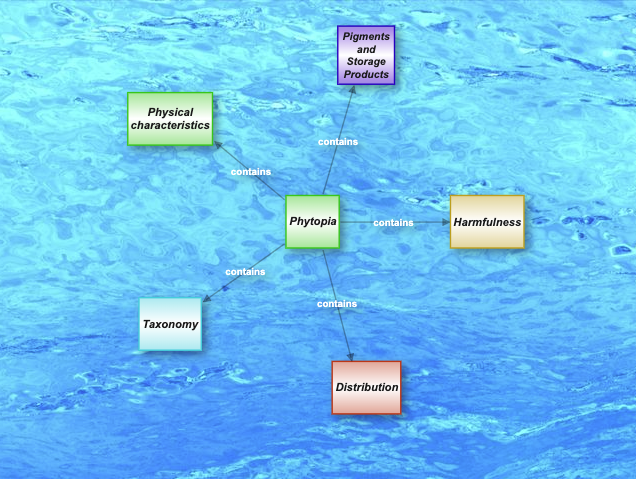
Exploring Within Phytopia
When Phytopia is launched, the concept that was initially clicked appears in the center of a map, linked to all of its related concepts.
- Clicking on any concept will cause it to become the center of a new map.
- A record of the concepts that have been previously viewed will appear under Your Journey.
- To return to a previous concept, click on its name in the Your Journey area.
- You may also use the controls to hide or remove items from Your Journey.
Color-Coded Topics
The concepts in Phytopia are grouped into broader topics, which are indicated by color.
- On the screen, the topic groups are shown on the left.
- Click on the legend icon to reveal the topics.
- Click an individual color box in the legend to hide or show that group of concepts.
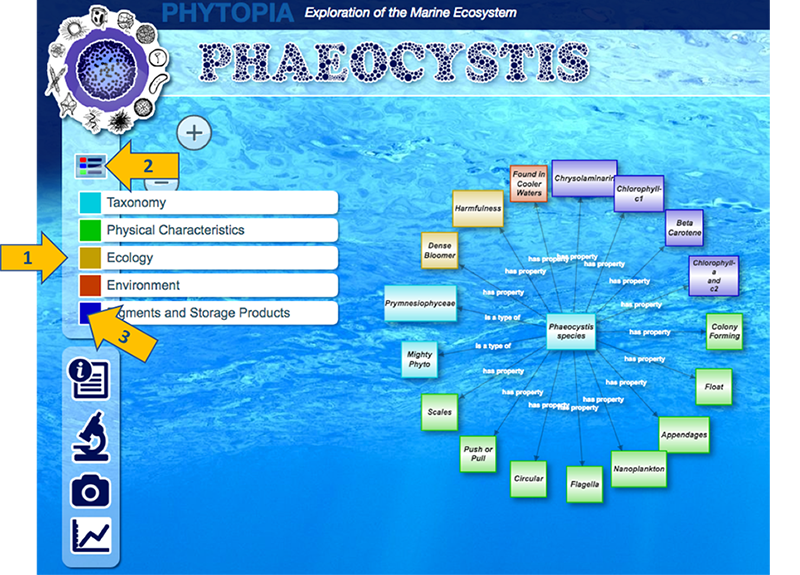
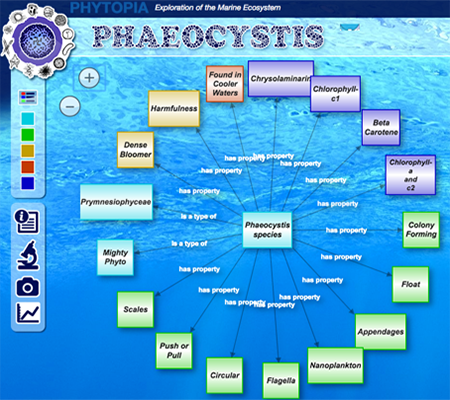
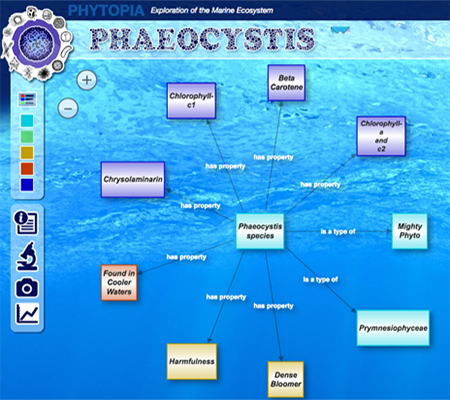
Multimedia Assets and Information
Every concept in Phyopia has a definition, and all of the species in Phytopia have additional media, or "assets", that can be viewed once you have selected the species. When a species is selected, a menu of icons will appear on the left or bottom of the screen. Not all species have all types of assets, so the icons for each type will appear when there are any assets available.
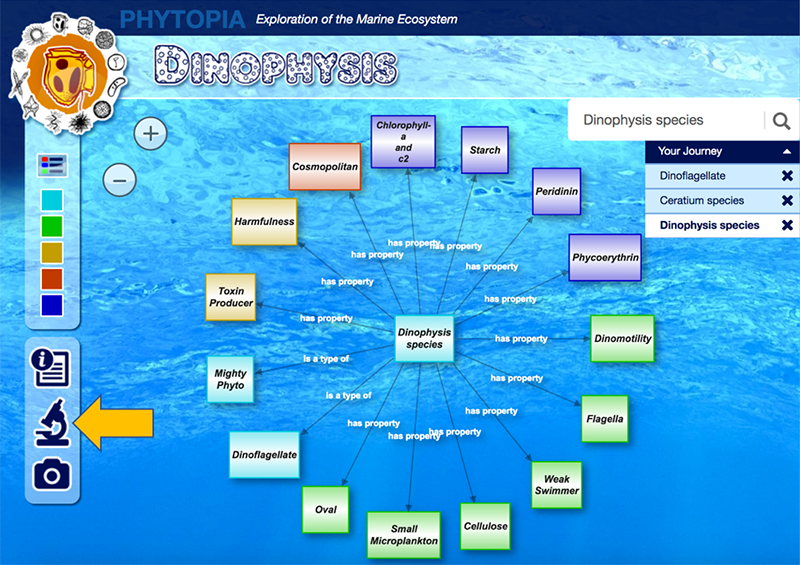
| Information: A definition of a term, or a description of a species. | |
| Microscope: Accesses a series of images of the species at different magnifications, and under different types of light. | |
| Images: Additional images of the species. | |
| Videos: Videos of the species in motion. | |
| : A plot of the absorption spectrum that can be used to identify a plankton species. |
Microscope View
| To view microscopic images of the phytoplankton at different magnifications and types, click the microscope icon. A pop-up window will open with a central viewing area at the lowest magnification settings under visible light. |
In this window, you can:
- Select a different level of magnification by using the choices on the left.
- Drag the viewing window to reveal more of the image.
- Switch to a different type of view (including epifluorescence and SEM, if available) using the choices at the top.
- Close the microscope viewer, click the x.

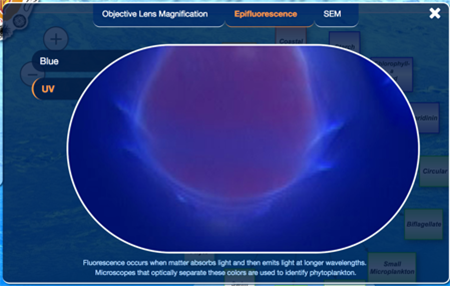
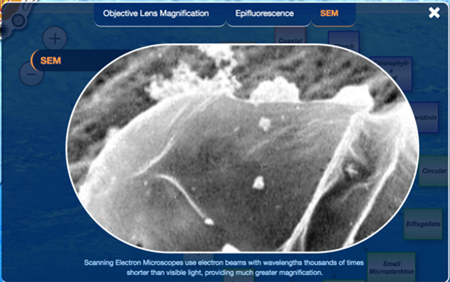
Images
| Many of the phytoplankton species have additional images, and these can be viewed by clicking on the camera icon. |
- When opened, the images are displayed in a slideshow format that will auto-advance.
- The images can also be browsed by using the > and < controls.
- To close the image viewer, click the 'x'.
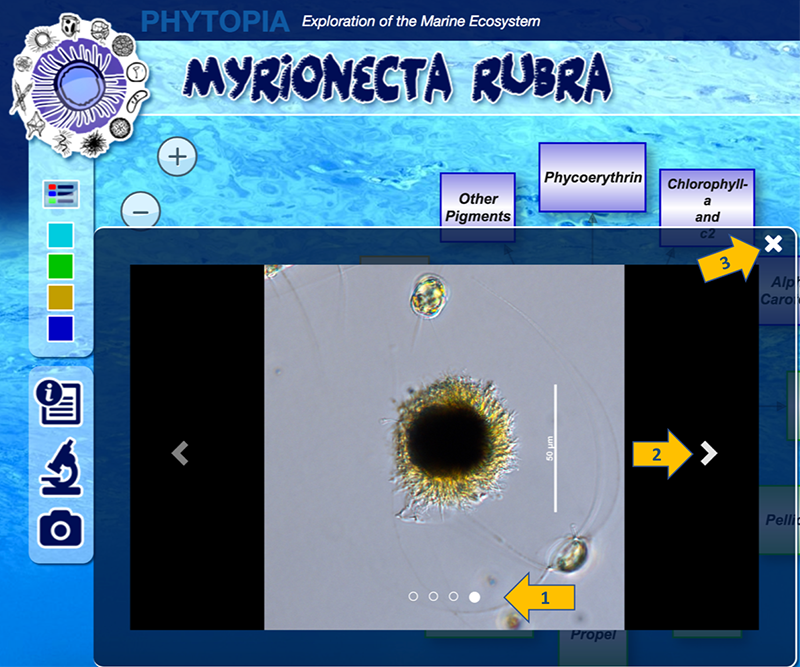
Videos
| A few of the phytoplankton species have videos (often to highlight their unique ways they swim or move), and these can be viewed by clicking on the play button icon. |
- When opened, the videos are displayed in a slideshow format.
- The videos can also be browsed by using the > and < controls (if there is more than one video).
- Use the video player controls to play, pause or stop the video.
- On some browsers, you may also have the option to download the original video file.
- To close the video viewer, click the 'x'.
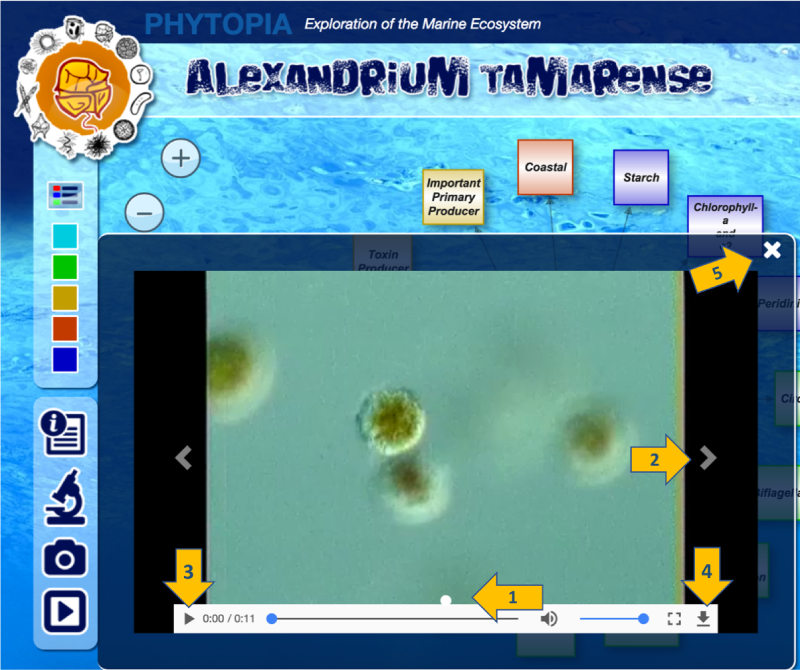
Spectra
| Species with this icon have data for the absorption spectra for that organism - a plot of its absorption by wavelength. This unique curve helps researchers to identify species of phytoplankton by looking at their pattern of absorption of light. |
- The spectra will appear in a pop-up window.
- The name of the species is listed in the top right of the window.
- To close the spectra viewer, click the 'x'.
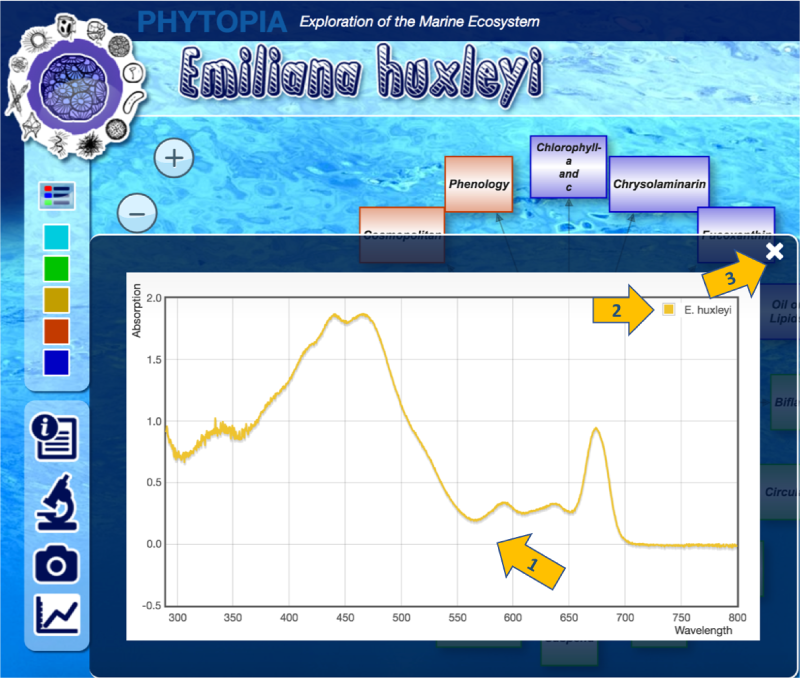
Student Exploration
- Task students with collecting information about phytoplankton using the "Get to Know Phytos - Student Sheet ."
- As students work through the Student Sheet, they should use information provided in the different colored boxes within the concept maps (i.e., for #2, students should explore the red boxes of different locations to evaluate where we find the greatest and least distribution.)
- Tell students that they should be prepared to discuss their findings with the class.
Wrap Up
- Students should return their attention to their original list/concept map of preconceptions about phytoplankton.
- Using a different color pen or pencil, students should add (and likely correct by striking through) some of their ideas from the beginning of the class. (Point out that no erasing is allowed.)
- Students share their findings with the class.
Disciplinary Core Ideas:
- LS1A: Structure and Function
- LS2A: Interdependent Relationships in Ecosystems
- LS2B: Cycles of Matter and Energy Transfer in Ecosystems
- LS4C: Adaptation
Crosscutting Concepts:
- Cause and Effect
- Systems and System Models
- Structure and Function
Science and Engineering Practices:
- Planning and Carrying out Investigations
- Analyzing and Interpreting Data
- Identify common physical and behavioral characteristics of phytoplankton
- Examine classes of phytoplankton for their distribution around the global ocean
- Analyze different species for their harmful impacts on the Biosphere
- Compare/contrast the role of pigments found in phytoplankton
- Explore, characterize, and sketch three species of phytoplankton of their choice
- How do phytoplankton differ around the globe?
Phytoplankton are the foundation of the aquatic food web, the primary producers, feeding everything from microscopic, animal-like zooplankton to multi-ton whales. Small fish and invertebrates also graze on the plant-like organisms, which are eaten by larger marine animals and so on. Like land plants, phytoplankton consume carbon dioxide and produce oxygen during photosynthesis. In fact, phytoplankton created about half the oxygen we breathe today. Phytoplankton are extremely diverse, varying from photosynthesizing bacteria (cyanobacteria) to plant-like diatoms, to armor-plated coccolithophores (drawings not to scale).

Phytoplankton growth depends on the availability of sunlight and nutrients. When conditions are favorable, phytoplankton populations can grow at a rate faster than they are consumed, a phenomenon known as a bloom. Phytoplankton blooms may cover hundreds of square kilometers and are easily visible from space. In this image, ocean waters glow peacock green off the coast of Scandinavia on July 18, 2018. Phytoplankton blooms often occur along coastlines where deep, nutrient-rich waters well up from the ocean depths. The light color of this ocean water suggests the calcite plating of coccolithophores is turning the water milky.
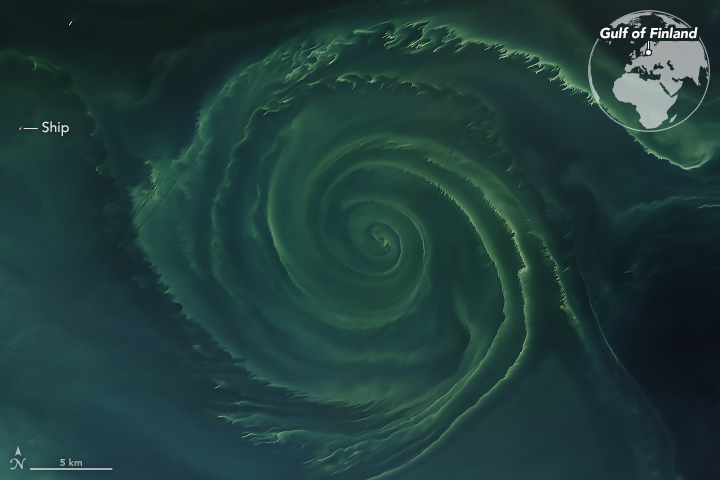
During photosynthesis, phytoplankton consume carbon dioxide on a scale comparable to land plants. Some of this carbon is carried to the deep ocean when phytoplankton die and sink, and some is transferred to different layers of the ocean as phytoplankton are eaten by other creatures, which themselves generate waste and die. Worldwide, this biological carbon pump transfers about 10 gigatonnes of carbon from the atmosphere to the deep ocean each year. Even small changes in the growth of phytoplankton may affect atmospheric carbon dioxide concentrations, which feed back to global surface temperatures.
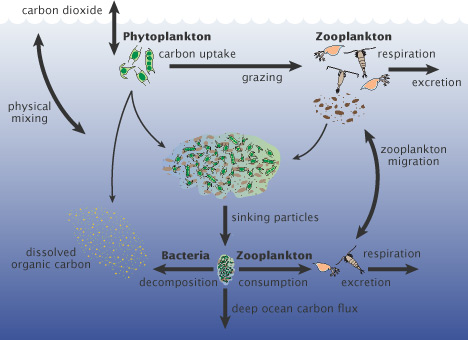
Credit: NASA Earth Observatory
- the differences between physical and behavioral properties, traits, adaptations
- photosynthesis and pigments' role in this process
- understanding that species are distributed around the world in different environments and quantities for various reasons
- basic understanding of light properties as they relate to colors and pigments
- use and creation of Venn Diagrams
- Phytoplankton are too small to be important—trees win.
- Algae (phytoplankton) are plants
THE OCEANOGRAPHY CLASSROOM • 110 Misconceptions About the Ocean
Feller, R.J. 2007. Education: 110 misconceptions about the ocean. Oceanography 20(4):170–173, https://doi.org/10.5670/oceanog.2007.22.
Our ocean teems with life and many of its most vital species are invisible to us. Like on land, the ocean has deserts, forests, meadows, and jungles, providing habitats for many forms of life. The types of life in these habitats are determined by microscopic algae that float in our ocean. Known as “phytoplankton,” these tiny organisms come in many different shapes, sizes, and colors. The diversity of phytoplankton types determines the roles they play in ocean habitats. It also determines how well they capture energy from the sun and carbon from the atmosphere.
Phytoplankton provide food for small zooplankton, tiny animals that float in our ocean. Like humans, these grazers actively select their food. In the same way, larger zooplankton prey upon smaller zooplankton. Step by step, energy captured from phytoplankton transfers to bigger creatures. As the energy climbs the marine food web, it can ultimately be used by humans.
The ocean is a fluid that is constantly in motion. Hosting the largest three-dimensional living space on earth, it supports many habitats. For example, the North Atlantic is home to highly productive "forests" each spring. Its blooms of carbon-rich phytoplankton fuel the fisheries of New England. The crystal-clear waters around Florida host productive coral reefs and fisheries. At times, however, this area is plagued by toxic phytoplankton.
Today's satellites reveal the quantity of phytoplankton at the ocean surface. Yet we cannot detect the diversity of species. For the first time, NASA's PACE satellite will:
- Reveal the diversity of phytoplankton found in our ocean on global scales;
- Allow us to understand the role that phytoplankton diversity has on life in the ocean; and
- Help us predict the “boom or bust” of fisheries along with marine hazards such as harmful algal blooms.
- Molecular and Cellular Biologist - Study cellular molecules and organelles to understand cell function and organization.
- Marine Biologist/Biological Oceanographer - research biological oceanography and the associated fields of chemical, physical, and geological oceanography to understand marine organisms.
Consider 3D printing or modeling phytoplankton (using everyday household items). See C-MORE's Plankton Curriculum- Lesson 2: Design Your Own Phytoplankton for inspiration!
- Internet Required
- One-to-One (tablet, laptop, or CPU)
- One-to-a-Group

